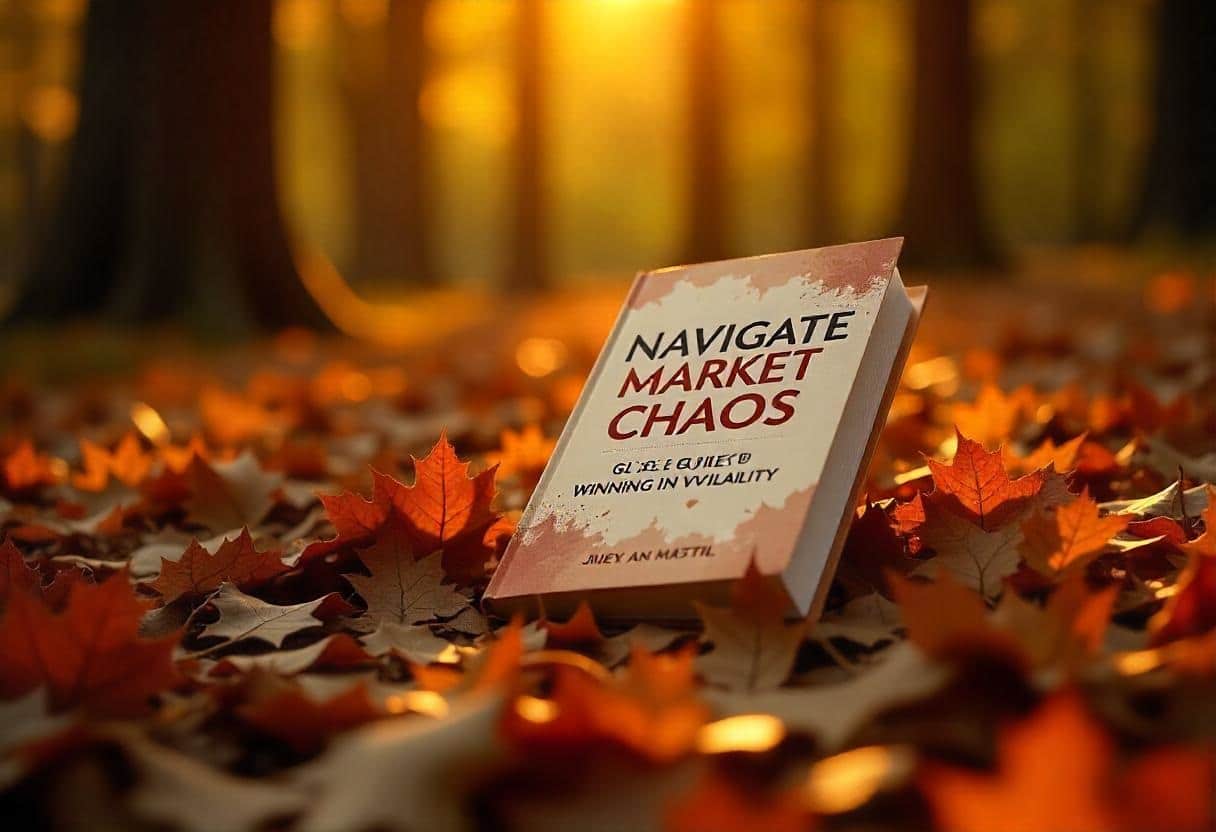Organizations that face challenges in unpredictable market conditions require proven survival strategies. Our Guide to Winning in Volatility presents tested methods that enable you to maintain your lead and confidently take decisions.
Current market instability remains an ongoing challenge because it destroys investors who lack preparation within brief periods. Investments and good investment decisions have become increasingly challenging since price fluctuations alongside unexpected global events and market emotions create immense challenges for protection.
Most investors struggle between fearful instincts and greedy impulses considering what they should do with their money. The ability to succeed in confusing market situations has taken center stage because of its vital importance today. Our Guide to Winning in Volatility provides necessary tools and methods to transform unforeseeable markets into sustained successful opportunities for investors. People who learn this strategy will achieve stability while making decisive actions and accumulating wealth regardless of erratic market movements.
Understanding Market Volatility
Financial markets behave as stormy conditions which produce panic among investors attempting to find protection through investments. What does the term volatility indicate for your investment assets? The level of price changes in assets across time constitutes volatility in simple terms. Price movements become excessive during unstable market conditions because of rapid factors including investor sentiment along with rumors and breaking news. Economic disruptions and geopolitical tensions produce panic that unexpectedly causes stock prices to drop.
Market volatility does not signify a given direction in asset prices. The process requires a proper intervention strategy when you grasp the fundamentals of shifting market dynamics. The Guide to Winning in Volatility explains market movements to allow investors better forecasting abilities by finding temporary market mispricing opportunities. Educating yourself about volatility enables you to recognize it as a favorable situation where you can identify inexpensive assets for purchase while making informed trading decisions. Before designing a resilient investment plan it is essential to grasp nonprofit and profit dynamics.
Psychological Impact of Volatility
Financial markets experience volatility that makes investors need to find protective places. The meaning of volatility applies specifically to how your investments perform. The level of price changes in assets across time constitutes volatility in simple terms. Price movements become excessive during unstable market conditions because of rapid factors including investor sentiment along with rumors and breaking news. Economic disruptions and geopolitical tensions produce panic that unexpectedly causes stock prices to drop.
Market volatility does not signify a given direction in asset prices. The process requires a proper intervention strategy when you grasp the fundamentals of shifting market dynamics. The Guide to Winning in Volatility explains market movements to allow investors better forecasting abilities by finding temporary market mispricing opportunities. Educating yourself about volatility enables you to recognize it as a favorable situation where you can identify inexpensive assets for purchase while making informed trading decisions. Knowledge about such uncertainties creates a foundation to build a robust investment strategy.
It becomes straightforward to experience overwhelming feelings during market instability. Investors who achieve the most successful outcomes in uncertain times use specific guiding principles to make their decisions. Relevant principles surrounding successful volatility management receive detailed explanation in Winning in Volatility Guide to assist you through turbulent market periods.
1. Stay Informed, But Avoid Noise
The initial rule requires market awareness which must not shift into obsessive interest in the daily volatile market hysteria and baseless speculation. Examining market trends remains vital yet deep fixation on short-term market movements should be avoided since it generates excessive worry and poor choice-making. Reliable news sources provide all the necessary market information you need so check these sources while avoiding news items that cannot affect your investment decisions.
2. Focus on Fundamentals
The principle of investing becomes difficult to remember during times of intense market price instability. The main principle stays focused on long-term visions. Investigate stock and bond values and asset potential through fundamental evaluation processes of core worth and corporate stability in addition to future expansion prospects rather than momentary market fluctuations. A fundamental analysis of your stocks will protect you from making poor decisions stirred up by market emotions.
3. The Role of Liquidity
Financial market stress makes liquidity extremely essential because it allows investors to execute purchases or sales swiftly without triggering excessive price changes. You need sufficient cash or liquid portfolio assets to avoid compulsion for selling your investments in a market downturn. Having ample cash reserves lets you capitalize on changed market conditions since they create favorable buying situations.
The outlined principles offer you a robust system to manage investments during unstable periods by transforming risks into beneficial chances. The Guide to Winning in Volatility helps investors secure success during market conditions which offer their most demanding conditions.
Proven Strategies for Winning in Volatile Times

The proper investment approaches enable you to transform market uncertainty into future triumphs. The Guide to Winning in Volatility presents multiple established investment approaches that successful traders deploy throughout volatile market conditions to achieve better results.
1. Dollar-Cost Averaging (DCA)
Among the most effective investment approaches to mitigate market volatility effects is dollar-cost averaging. Regular periodic investment creates fixed amounts without considering market price fluctuations to prevent investing at unfavorable times. By using this method in the long term you achieve price distortion reduction that lets you buy more shares while prices stay down and purchase fewer shares when prices are high.
2. Portfolio Diversification
Diversification stands as the best method to minimize how volatility affects your complete investment profile. Attribute your investments to various asset classes which includes stocks, bonds, real estate and commodities because this technique lowers risk exposure while improving your chances for stable financial returns. Diversification delivers its best effects during unstable market periods because particular asset classes tend to perform better during down cycles of others.
3. Hedging Strategies
Established investors benefit from hedging as a defense system which safeguards their investment portfolio during market fluctuations. The technique of hedging requires investors to utilize financial instruments comprising options and futures or inverse exchange-traded funds (ETFs) to minimize losses in other asset groups. The hedge strategy increases portfolio complexity but delivers relevant safety protection during declining market conditions
4. Setting Stop-Losses Wisely
Users can program their assets to automatically trigger sales once their prices reach specific defined levels with stop-loss orders. Stop-loss orders provide beneficial protection from market losses but it requires proper risk manager skill to determine stop-loss placement.
The position you set for stop-losses determines if temporary market fluctuations will trigger asset sales at incorrect times with restrictive setups or leave you at risk of major losses when parameters are set wide. To prevent risk-management problems from occurring through overreacting to price fluctuations it is essential to maintain proper equilibrium.
These strategies help minimize volatility’s psychological effects which enables you to build sustainable long-term growth. The Guide to Winning in Volatility instructs investors to use these techniques which maintain peace of mind and strong resolve regardless of market conditions.
Risk Management Techniques
Managing volatile markets requires more than selecting the right investments because it involves effective risk exposure management too. Inside the Guide to Winning in Volatility you will discover fundamental risk management systems which protect your investment portfolio but also allow you to exploit market possibilities.
1. Calculating and Controlling Risk Exposure
Risk assessment about what you can tolerate stands as a vital requirement before investing your money. You should assess both the value potential and their potential for loss as well as the amount of assets you are risking from any single investment. The basic investment guideline states you must not place too much of your finances in one investment because it will intensify your market volatility risks.
The initial step of risk management exists in establishing your risk thresholds. Knowing your risk tolerance represents the biggest threshold of investment loss that establishes the point at which you should take action in your portfolio. The Kelly Criterion and portfolio simulation software provide quantitative measurements which enable users to modify their investment exposure successfully.
2. The Importance of Position Sizing
When establishing a position you need to determine how much capital each individual investment will receive. During times of market instability and volatility your position sizing adjustments will reduce the negative effect of losing money in your trades. You should decrease the quantities of investments in unpredictable sectors and volatile assets when markets decline because this reduces potential financial loss during such times.
Risk tolerance influences the direct determination of your positions’ sizes. Using smaller position sizes minimizes the volatility in your entire portfolio even though it means achieving lower potential returns compared to larger position sizes that involve higher risks. Your investment protection against major losses becomes possible through strategic adjustments of position size based on market conditions.
3. Building a “Margin of Safety”
Sarah offers investors worldwide including Warren Buffett and Benjamin Graham the margin of safety approach which serves as a fundamental risk management tool suited for markets with high volatility. This strategic method includes buying investments at deeply discounted value levels so your capital holds enough protection against market dynamic changes and unforeseen market uncertainties.
Safety buffers in your investment allow cautious behavior as the lowered purchase price creates space to mitigate losses from market fluctuations. Using this investment methodology will not protect your entire investment but it will greatly decrease the probability of permanently losing your initial amount during unpredictable market situations.
Your investment strategy benefits from using these risk management methods which protect your resilience during any market situation. Risk management through volatile market periods represents an absolute necessity according to the Guide to Winning in Volatility since it provides financial security in all economic situations.
Staying Patient and Focusing on Long-Term Goals
Market volatility creates intense urges for investors to take hurried impromptu actions. The essential element for achieving success relies on patience. Numerous investors end up making substantial missteps by engaging in market timing schemes and short-term profit seeking. Your odds increase for surviving through market turbulence when you stand by your long-term objectives and keep discipline in your approach.
The Guide to Winning in Volatility stresses the significance of thinking and behaving patiently over the long run. Time the market remains challenging for investors but history demonstrates markets naturally recover and expand in the long run. Individual investors saving for retirement along with people building wealth for their descendants must maintain their focus on their financial targets.
1. Avoiding Emotional Reactions
Long-term investment plans undergo harm from emotional reactions especially when markets experience great periods of volatility. People quickly fall into these two damaging behaviors because of their concern about money loss and their determination to achieve maximum profits fast. The combination of uncontrolled emotions produces decisions that could push investors to make price peaks at the height of a market rally or force them to sell during market hysteria. Through the Guide to Winning in Volatility you can find methods to control your emotions which enables consistent implementation of your investment strategy despite market volatility.
2. The Power of Compounding
The long-term perspective in investing provides investors with the most significant benefit known as compounding. Allowing investments to expand across time creates an effect where accrued returns both increase in value by themselves. The power of compounding works magnificently during price volatility because assets briefly decline in value. You can achieve greater investment growth by choosing long-term patience rather than selling early since markets will return to value eventually.
3. Rebalancing Regularly
The essential practice for maintaining focus on long-term goals demands that your portfolio matches your investment targets. Regular portfolio rebalancing helps protect against excessive risk exposure during market volatility so that you maintain a diversified structure which follows your future financial goals. You can benefit from price changes by purchasing assets at bargain prices while selling them at premium prices.
Successful navigation of volatility depends on patience since long-term goal focus enables you to handle market movements and achieve better results.
Learning from Market Cycles and Past Crises

Knowing how markets operate during times of market volatility enables effective decision-making along with peaceful management of uncertainty. The Guide to Winning in Volatility teaches readers to examine market cycles and historical crises so they can derive useful knowledge for their present and future investment decisions.
1. Recognizing Market Cycles
Various economic, political and social factors determine the presence of market cycles that normally show expansion together with contraction periods. Asset prices move up during periods of expansion yet they decline throughout times of contraction. To manage uncertainty we need to determine our position within existing market cycles. Understanding the current market trend between bull and bear conditions allows investors to optimize their strategies for capturing present market opportunities.
Your investment strategy should be aggressive when the market shows boom and defensive during bear market conditions. Guide to Winning in Volatility provides readers with strategies to identify volatility cycles and select appropriate investment strategies based on those cycles.
2. Drawing Lessons from Past Crises
History has shown that market crises — whether financial crashes, geopolitical events, or natural disasters — are a part of the economic landscape. While these events can cause extreme volatility in the short term, they also present opportunities for those who are prepared. By studying past crises, such as the 2008 financial crisis or the COVID-19 market crash, you can identify patterns and reactions that can inform your decisions in the future.
One of the most valuable lessons from past crises is that volatility often leads to long-term market recovery. Investors who held on through tough times were often rewarded once the market rebounded. The Guide to Winning in Volatility emphasizes that while crises are painful, they also offer a unique opportunity to purchase undervalued assets that can perform well once the market stabilizes.
3. Adjusting Your Strategy Based on Experience
Every economic cycle together with market instability offers learners the chance to gain knowledge. The tracking of your investment experiences as well as their performance outcome during volatile times gives you fundamental data to improve your future strategy. You can improve your approach to future volatility by reviewing victories and setbacks together with failures you have encountered. The Guide to Winning in Volatility guides you to write down your investment choices together with reviewing portfolio outcomes across market cycles before adapting your trading strategy.
Learning from previous investor achievements and market cycle patterns helps you develop better decisions for the upcoming volatile situations.
The Role of Technology and Tools in Volatile Markets
The current fast-moving financial world heavily depends on technology for investors to handle market volatility effectively. Using appropriate tools enables you to receive updates and develop better choices while controlling risk more effectively. The Guide to Winning in Volatility demonstrates why technology becomes essential for leading market changes when volatility controls financial operations.
1. Financial Analysis Software and Tools
Success in volatile markets depends on having precise and contemporary market data as the starting point. Bloomberg Terminal and Morningstar as well as TradingView provide investors with sophisticated systems to investigate financial data and monitor market patterns and thoroughly analyze their assets. The notification systems available through these tools supply investors with current market improvements so they can execute timely responses to market movements.
The tools provide all-encompassing evaluation capabilities which enable users to spot overlooked assets as well as monitor current market rates while analyzing past market patterns to grasp cyclical market behavior better. Guide to Winning in Volatility demonstrates that these resources serve as essential tools for acquiring market advantage during unstable market conditions.
2. Robo-Advisors and Automated Investment Platforms
The market volatility attracts investors toward robo-advisors because they need automated support for handling data analysis without sacrificing long hours at their desks. Digital portfolios built by algorithms adjust portfolios according to your investment risk thresholds and financial targets. The automated nature of robo-advisors helps investors manage their emotions by means of automated decision-making during periods of market instability.
Although robo-advisors perform automatic portfolio rebalancing based on market movements you can stay away from issuing short-sighted investment decisions because their systems respond to market shifts. A hands-off investment experience can be achieved using automated platforms for reaching long-term financial success as explained in The Guide to Winning in Volatility.
3. Real-Time Alerts and Notifications
The essential requirement during market volatility is quick reaction while monitoring all assets and market movements remains challenging. Users who subscribe to Robinhood or E*TRADE or Fidelity receive real-time alert notifications which keep them updated about price fluctuations as well as news breaking events alongside possible threat situations. Real-time market notifications enable you to take quicker decisions supported by accurate information rather than maintaining constant manual monitoring.
The setup of investment criteria-based alerts will keep you notified for immediate action whenever market volatility kicks in. The Guide to Winning in Volatility provides students with necessary tools to utilize alerts successfully for managing their investments throughout unpredictable market situations.
4. Predictive Analytics and AI Tools
Artificial intelligence (AI) systems together with predictive analytics tools transform investor processes when dealing with market volatility. The analytic systems use extensive data evaluation to produce forecasts about upcoming market direction which provides market outlook for future behavior. The helpfulness of AI tools lies mainly in their ability to help risk management by providing better decision-making capabilities during unpredictable market periods.
AI serves as the core focus of the Guide to Winning in Volatility because it analyzes market patterns to help investors both decrease their exposure to avoidable risks and spot promising investment opportunities in advance. The inclusion of artificial intelligence insights in your investment approach leads to enhanced volatility management capabilities.
Building a Resilient Portfolio
A resilient portfolio demonstrates the ability to survive market shocks that occur during times of market volatility. According to the Guide to Winning in Volatility effective security portfolios need diverse components and the ability to adapt along with regular evaluations in order to survive and perform well under market turbulence.
1. Diversification: The Key to Mitigating Risk
Diversification stands as the most practical method for portfolio protection and risk reduction during times of market uncertainties. Your investment portfolio remains protected from major setbacks since you have distributed assets into multiple classes and sectors and geographic areas.
Diversification enables your investments to offset each other because stable sectors and asset classes provide protection from the downturns in other areas. True diversified portfolios extend past two main asset classes according to The Guide to Winning in Volatility. Real estate along with commodities and international investments added to your investment mix will develop a stronger portfolio that stands against market turbulence.
2. Regular Portfolio Review and Rebalancing
Diversification does not eliminate the need for regular portfolio review because holdings might need periodic adjustments for balance control. The natural market fluctuations can alter investment performance levels which makes your portfolio distribution become unbalanced. A volatile market period intensifies risk exposure and restricts potential gains because of portfolio unbalance.
A portfolio rebalancing requires asset purchases or sales to preserve the targeted investment distribution among assets. As described in the Guide to Winning in Volatility, periodic portfolio rebalancing enables people to maintain investment goals and risk tolerance while adjusting to market changes.
3. Incorporating Alternative Investments
The standard financial instruments such as stocks and bonds form crucial investments in fund structures but alternative financial vehicles deliver added worth during uncertain times. Alternative investment classes which consist of private equity, hedge funds and real estate demonstrate a limited relationship to stock market performance so they offer extra protection during times of traditional market turbulence.
Using alternative investments serves as an effective strategy to control market volatility while achieving better output results. The Guide to Winning in Volatility details effective implementations of these investments to build portfolio strength which leads to better long-term performance.
4. Maintaining Flexibility to Adapt to Changing Conditions
Customers need to remain flexible when dealing with volatile markets. Financial markets transform on a regular basis thus requiring strategic adjustments based on current market data and conditions. A resilient portfolio exists as a dynamic system that adapts through changing environmental conditions because it was developed to react to new situations.
The resilience of your portfolio relies on active pursuit of new opportunities along with regular assessment of risk tolerance along with options to change your approach at any time. Investors according to The Guide to Winning in Volatility should implement adaptable strategies because market adaptability leads to long-term performance.
Success Stories: Learning from Those Who Thrived in Volatile Markets
Various investors prove through experience that they can handle market volatility to build stronger investment positions. The Guide to Winning in Volatility uses real-life situations to demonstrate that market volatility should be seen as a chance for growth rather than a cause for concern.
1. Case Study 1: Warren Buffett’s Approach During Market Crashes
Throughout his decades as a successful investor Warren Buffett has experienced his most significant growth during market downturns. Buffett became famous for his statement about being afraid during greedy times and greedy when fear rules the market. Buffett has succeeded through market changes by acquiring underpriced companies thus accumulating significant wealth throughout his investment career.
The essential core of Buffett’s teachings shows people how maintaining patience through market panic allows them to buy fundamental-based companies at fair prices. Guide to Winning in Volatility recommends adopting the same approach by avoiding impulsive choices when markets are volatile to concentrate on enduring corporate value.
2. Case Study 2: The Rise of Netflix During the 2008 Financial Crisis
The 2008 financial crisis struck various businesses with falling stock prices though Netflix emerged as an exception and their stock value grew. The global crisis caused business troubles for many companies yet Netflix seized the increased demand for video streaming service. The company benefited from growing streaming service popularity because its stock price grew substantially during economic difficulties.
Netflix illustrates through its success that shifting operations into compelling emerging trends can lead to remarkable results during unstable economic periods. This book instructs readers to remain flexible and maintain constant innovation while perceiving possibilities within difficult circumstances.
3. Case Study 3: The Resilience of Gold During Economic Turmoil
Throughout periods of economic chaos and inflationary times people traditionally seek safety in gold as an asset. Investors who maintained gold ownership throughout financial chaos periods starting with the 2008 financial crisis and including COVID-19 experienced their investments increase in value. Because of its established status as a valuable store of wealth, gold serves as a perfect illustration of an investment that thrives during times of increased market volatility.
Market volatility demonstrates the wisdom of spreading investments across assets that maintain little or no connection to stock market performance because gold proved successful during these times. According to the Guide to Winning in Volatility investors need defensive assets including gold to protect their portfolios in unpredictable market situations.
Conclusion
The process of managing market volatility requires both optimistic thinking and specific strategic instruments along with adequate expertise. Most investors achieve success when they choose to welcome volatility rather than avoiding it according to the Guide to Winning in Volatility. A successful volatility strategy emerges from portfolio diversification strategies combined with technological market research and studying effective investment practices recorded by past investors. Your ability to succeed across volatile markets will develop from your adaptation to changing situations while you maintain your vision of the future.
Treating volatility as an opportunity represents wiser strategy compared to viewing it as dangerous. Your ability to succeed in market fluctuations increases when you launch your adaptable strategy shortly before changes happen. Through the Guide to Winning in Volatility users gain the opportunity to build their investment approach now to prepare for the future. Your ability to transform market doubt into business advancement stems from proper tools and perspective. Construct your strategy right away because volatile conditions will become beneficial to you.
What is market volatility, and why is it important for investors?
Market volatility refers to the degree of price changes in assets over time. It’s driven by factors like investor sentiment, economic disruptions, geopolitical tensions, and breaking news. Understanding volatility is crucial because it helps investors anticipate price fluctuations, identify opportunities to buy undervalued assets, and make informed decisions to protect and grow their investments.
How does market volatility affect my investment decisions?
Volatility can create uncertainty, triggering emotional reactions like fear or greed, which may lead to impulsive decisions. By learning to manage volatility, as outlined in the Guide to Winning in Volatility, you can focus on long-term goals, use strategies like diversification and dollar-cost averaging, and avoid reacting to short-term market noise.
What strategies can I use to succeed in volatile markets?
The Guide recommends proven strategies, including:
- Dollar-Cost Averaging (DCA): Invest fixed amounts regularly to reduce the impact of price fluctuations.
- Portfolio Diversification: Spread investments across asset classes like stocks, bonds, real estate, and commodities to lower risk.
- Hedging: Use financial instruments like options or inverse ETFs to protect against losses.
- Setting Stop-Losses: Program automatic sales at specific price levels to limit losses, but set them carefully to avoid triggering during temporary dips.
How can I manage the psychological impact of market volatility?
Volatility can evoke fear or greed, leading to irrational decisions. The Guide suggests:
- Staying disciplined by focusing on long-term goals.
- Avoiding emotional reactions by sticking to a well-defined investment strategy.
- Using tools like robo-advisors to automate decisions and reduce emotional interference.
What role does risk management play in volatile markets?
Effective risk management is essential to protect your portfolio. Key techniques include:
- Calculating Risk Exposure: Assess your risk tolerance and avoid over-investing in a single asset.
- Position Sizing: Adjust the amount of capital allocated to each investment to minimize losses during downturns.
- Margin of Safety: Buy assets at discounted prices to create a buffer against market declines.
Why is patience important during market volatility?
Patience helps you avoid impulsive actions driven by short-term market swings. The Guide emphasizes that markets historically recover over time, and staying focused on long-term goals, leveraging compounding, and regularly rebalancing your portfolio can lead to better outcomes.
How can I learn from past market crises?
Studying historical crises, like the 2008 financial crisis or the COVID-19 market crash, reveals patterns and opportunities. The Guide notes that volatility often leads to recovery, and investors who buy undervalued assets during downturns can benefit. Reviewing your own investment decisions during past volatility also helps refine your strategy.
What makes a resilient portfolio?
A resilient portfolio withstands market shocks through:
- Diversification: Spreading investments across asset classes, sectors, and regions.
- Regular Rebalancing: Adjusting holdings to maintain your desired risk level.
- Alternative Investments: Including assets like real estate or commodities that are less correlated with stocks.
- Flexibility: Adapting to changing market conditions with proactive adjustments.
Can you provide examples of investors who thrived in volatile markets?
The Guide highlights:
- Warren Buffett: He capitalized on market crashes by buying undervalued companies, emphasizing patience and fundamental value.
- Netflix (2008 Crisis): The company pivoted to streaming, leveraging emerging trends to grow during economic turmoil.
- Gold Investors: Gold’s value rose during crises like 2008 and COVID-19, showcasing its role as a safe-haven asset.
How do I start building a strategy for volatile markets?
Begin by educating yourself about volatility using resources like the Guide to Winning in Volatility. Diversify your portfolio, adopt risk management techniques, stay patient, and leverage technology for data-driven decisions. Regularly review and adapt your strategy based on market conditions and past experiences.































